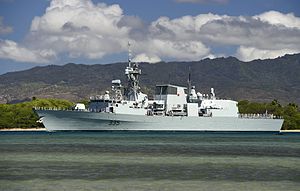
Back Třída Halifax Czech Halifax-klassen Danish Halifax-Klasse German ناوچه کلاس هلیفکس Persian Halifax-luokka Finnish Classe Halifax French Classe Halifax Italian ハリファックス級フリゲート Japanese Frigat Kelas Halifax Malay Fregaty rakietowe typu Halifax Polish
 HMCS Calgary in July 2014
| |
| Class overview | |
|---|---|
| Name | Halifax class |
| Builders | |
| Operators | |
| Preceded by | Annapolis class |
| Succeeded by | Canadian Surface Combatant |
| Built | 1987–1996 |
| In commission | 1992–present |
| Completed | 12 |
| Active | 12 |
| General characteristics | |
| Type | Guided-missile frigate |
| Displacement | 4,770 t (4,770.0 t) |
| Length | 134.1 m (440 ft 0 in) |
| Beam | 16.4 m (53 ft 10 in) |
| Draught | 4.9 m (16 ft 1 in) |
| Propulsion |
|
| Speed | 30 knots (56 km/h; 35 mph) |
| Range | 9,500 nmi (17,600 km; 10,900 mi) |
| Complement | 225 |
| Sensors and processing systems |
|
| Electronic warfare & decoys | TKWA/MASS (Multi Ammunition Softkill System) |
| Armament |
|
| Aircraft carried | 1 × CH-148 Cyclone helicopter |
| Aviation facilities | One landing pad and one hangar |
The Halifax-class frigate, also referred to as the City class, is a class of multi-role patrol frigates that have served the Royal Canadian Navy since 1992. The class is the outcome of the Canadian Patrol Frigate Project, which dates to the mid-1970s.[1] HMCS Halifax was the first of an eventual twelve Canadian-designed and Canadian-built vessels which combine traditional anti-submarine capabilities with systems to deal with surface and air threats as well. Ships of the class are named after capital cities of Canadian provinces (St. John's, Halifax, Charlottetown, Fredericton, Québec City, Toronto, Winnipeg, and Regina), the capital of Canada, Ottawa, and the major cities of Calgary, Montreal, and Vancouver.
In 2007, the Government of Canada announced a planned refit of the Halifax class which is known as the Halifax Class Modernization Project (HCMP) of which the Frigate Equipment Life Extension (FELEX) project is a part. In November 2008, a Lockheed Martin Canada-led team including Saab AB, Elisra, IBM Canada, CAE Professional Services, L-3 Electronic Systems and xwave, was awarded the contract. The construction phase of the program was completed in November 2016.[2] As of May 2021[update], the Halifax-class modernization program is being closed out, but full operational capacity was reached on 31 January 2018.[3]
In October 2011 the Canadian government launched the National Shipbuilding Procurement Strategy which aims to replace the Halifax class, as well as the capabilities of the Iroquois-class destroyers, with up to 15 new warships under the Canadian Surface Combatant. This replacement class is currently in the design stage and construction is anticipated to begin in the early 2020s. However, the Halifax-class vessels continue to be upgraded with at least some ships of the class anticipated as likely to continue service into the 2040s.[4]
- ^ Macpherson and Barrie, p. 289
- ^ Gunn, Andrea (28 November 2016). "Irving finishes frigate refits for navy". The Chronicle Herald. Retrieved 30 November 2016.
- ^ "Halifax-class modernization and frigate life extension". Government of Canada. 13 December 2018. Retrieved 13 May 2021.
- ^ "Davie Shipyard Begins Halifax-Class Frigate Mid-Life Refit Program". Naval News. 14 August 2020. Retrieved 17 August 2020.
© MMXXIII Rich X Search. We shall prevail. All rights reserved. Rich X Search